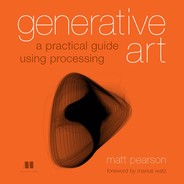About this Book
Within these pages, you’ll learn how to begin experimenting with generative art. We’ll explore tools and algorithms and creative approaches, and look at ways you can take ideas and develop them further. But there is one thing you won’t learn from this book, and that is how to be an “artist.”
If this book were to be just a collection of recipes for you to follow, to produce certain aesthetically pleasing results, it would be missing the point—not to mention hugely arrogant. The appreciation of art is entirely subjective, so if I were to declare that there is a right way to go about creating art, I would be in need of a slap.
Similarly, this isn’t a book about “design.” With design, the intention is to produce a visual that produces the same response in everyone who sees it—the intention (such as “street,” “retro,” or “subtle”) should be mostly unambiguous. With art, you’re still aiming to produce a response, but if that response is different in different people that doesn’t matter. It’s fine for one person to like a piece while another sneers. Even better, if one viewer loves the work, we would hope another might hate it. If we can foster such an extremity of reaction, it’d be a measure of success. Perhaps the only cardinal sin of art is to be boring.
This book is peppered throughout with stills from my own generative works, most of them relating to whatever topic is under discussion, but others are just randomly thrown in as a breather. Source code for many of these images can be downloaded from http://abandonedart.org and from the publisher’s website at www.manning.com/GenerativeArt. It is also published under a Creative Commons license, so you’re welcome to take these works and deconstruct them, adapt them, mash them up, and destroy them. But, importantly, you’re also entitled to think they’re rubbish. It wouldn’t bother me too much if you did—that isn’t the purpose of the book.
I would hope that even if you hated every single piece of artwork within these pages, you may still get something from the book, if only the inspiration to do something better. In this way, even bad art can be good, as it is only the very worst that can inspire an extreme reaction. To not produce any reaction at all is to fail as an artist.
If there is one thing I want to get across with this book, it’s a style of programming rather than a rulebook for achieving certain types of results. I want to explore how programmers can open themselves to more artistic flurries, a way of freeing the brain to get creative with code.
The roadmap for this approach is as follows: The first part of the book, “Creative Coding,” sets the scene and teaches all the necessary prerequisites. Chapter 1 looks at the concept of generative art from a few different angles; then, in chapter 2, we get up to speed with Processing, a simple programming language that will be our main tool for the rest of the book.
Part 2, “Randomness and Noise,” begins to break down my process for creating generative visuals with Processing, looking at the algorithmic creation of the simplest of forms, and considering new ways of approaching them. We begin with the drawing of a line in chapter 3; we see how even this can be spun out into interesting spaces with a more fluid approach, extending the idea to trigonometry with chapter 4. Chapter 5 explores animation and 3D drawing.
The final part of the book, “Complexity,” goes beyond the machine and looks at three organic processes taught to us by the natural world: emergence, autonomy, and fractals. We maintain a practical approach throughout though, exploring how we might simulate these phenomena in code, and learning, by stealth methods, more advanced object-oriented programming required for these experiments.
There is no right or wrong way to be a generative artist. There are no rules or recipes. Generative art is about the organic, the emergent, the beautiful, the imprecise, and the unexpected. It’s about exploring these within a world of logic and precise mechanics. This delightful paradoxicality makes it an almost Zen approach to computing: playful and organic, free of restraint, and inviting a natural flow.
To put it more simply, generative art is about having fun with coding. Programming isn’t just about good practice, structure, and efficiency; it can be about freedom, creativity, and expression, too. The programming language can be an artistic tool, capable of making both profound statements and banal ones, if in the right hands.
